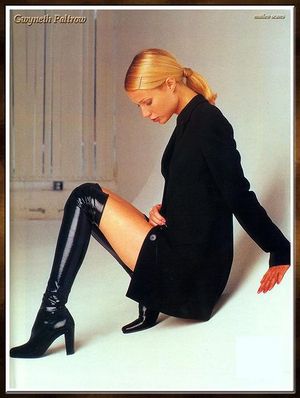Boots
Boots and associated imagery play a significant role in many forms of BDSM and fetish play, and latex fetish is no exception.
Boots made of rubber are functionally prized for their ability to resist water, which is a happy coincidence for latex clothing fans!
From practical Wellington boots to waders to high fashion creations such as Aquos high heeled boots and Victoria Beckham's Antonio Berardi heel-less boots, rubberists are fortunate to have an association with footwear.
Fetish shoe manufacturers also make high heeled stiletto boots with shafts of latex.
Classification
The normal categorisation of boots is by their intended use:
- Practical boots, i.e. ones also used outside the fetish scene from farming to city and to physically oriented jobs mainly for their protective properties against moisture or cold
- Dry weather boots, i.e. city boots that serve only aesthetic purposes with possibly a small protective element against chilly weather
- "Classy" boots, i.e. fashion boots and boots for festive occasions
- "Kinky" boots, i.e. boots with exaggerated features for aesthetic and sexual enjoyment
Boots can then be sub-classified on several properties, some of which are self-evident while others are only slightly less so.
- length
- material(s) used
- sole properties
- heel
- height
- shape
- platform
- heel
- toe shape, from pointy to round and square
- method of fastening
- zip
- laces
- buttons
- none (pull-on)
- decorations and finish
By length
- Ankle length, aka. booties
- half calf or 3/4 length, ending at the widest point of the calf
- knee high - that actually end just below the knee
- thigh high
- over-the-knee, aka. otk-boots
- normal
- high thigh
- crotch high
- chap boots
Materials
All of these are available in various grades of smoothness, from near rough to patent like mirroring surfaces
- leather
- synthetic leather (mostly mixtures of plastics and fabrics)
- PVC and other plasticy plastics
- rubber
- conventional fabrics, for example
- velvet
- denim
Sole
Heel height
Even most heelless boots feature a slight heel of 1 to 3 cm. Most orthopedics advise people to avoid using heels of over 4 to 7 cm (1,5 to 3 inches) but irregular usage is unlikely to cause anything other than discomfort - except for the very highest heels, ballet boots included, for which a strained ankle is a threat for the inexperienced.
Common shoes and boots marketed for daily use feature a 3 to 9 cm heel and some even 12 cm heels. For kinky boots heels of 12 to 15 cm are readily available. At over 15 cm the toes start to raise upwards and a boot can be considered as ballet boots if designed properly.
Some people claim to have trained themselves to walk easily in 5 to 6 inch heels for days at a time, by gradual introduction of higher heels.
Heel shape
Shapes vary from sturdy combat boots to stilettos.
It is commonly thought that narrower tips make walking in any shoes more difficult.
Platform
Platform height is the thickness of the boot sole under the ball of the foot. Technically any boot has a small platform, but only shoes with a platform of over (about) 2 cm are called platform shoes/boots. Conventional platform heights vary from few centimeters up to 5 cm but even higher platforms exist.
Toe shape
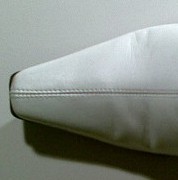 |
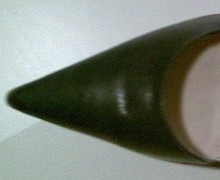 |
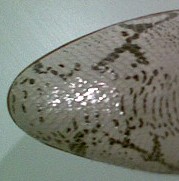 |
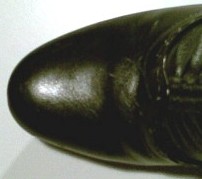
|
| Boot with square toes | Shoe with pointy toes | Bootie with curved toes | Boot with round toes |
Fastening
Some materials allow for sufficient stretch so that the boots can be simply pulled on the legs. Real and many imitation leathers, among other materials, don't have the necessary stretch and call for some method of opening the shaft of the boot for leg insertion or removal. Some boots feature both zippers and laces to get best of both worlds: fast dressing with the zipper and laces for adjustable fit.
Zippers
Zippers' teeth and the runner can be of metal or plastic, the former being more durable and often the material of choice in boots. Some boot enthusiasts even find the sound of a long and possibly sturdy zipper closing inviting or arousing.
Usually, there will be a flap behind the zip to stop the wearer's flesh being nipped by the closing zip or chafed by the zip during wear.
Zippers can run the whole length of the shaft or be limited to the narrowest part of the ankle - just long enough to allow the heel of the foot to fit through the narrow section.
Zippers are hidden or left visible and have been featured on all sides of the boot shaft. It can be speculated, though, that a zipper on the back of the leg is more likely to cause abrasion and subject to greater forces pulling the sides apart than a zipper places anywhere else.
Laces
Laces distribute the force pulling the sides apart on most of their length and are often considered more durable but closing the laces can take a long time. For some that is an advantage, as the task is well suited to a sexual servant. The string is run through holes or skate type fastening points along the entire length of the shaft and knotted at the end.
Laces allow for a tighter fit, as each spot can be pulled tightly against the wearer's skin. Laces are also required for an authentic look on roleplay scenarios set in the past when zippers were not available.
Other
Buckles and buttons have been used, too. Buckles are adjustable but with defined intervals only, unless accompanied by adjustable halters. They rely on the tightness of the buckle against the shaft to keep the shafts from moving against the wearer's skin. Buttons have a more prominent use as decoration, as their adjustability requires multiple connection points for each button and are most likely the first ones to pop open by themselves.
See also
Chat rooms • What links here • Copyright info • Contact information • Category:Root
